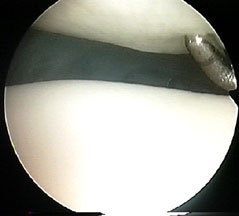Chondromalacia means 'softening of the gristle or joint cartilage' and usually refers to the kneecap (patella). The softening can be felt with a blunt probe during surgery.
 Page updated June 2024 by Dr Sheila Strover (Clinical Editor)
Page updated June 2024 by Dr Sheila Strover (Clinical Editor)

Normal joint cartilage of patella (seen above the femoral groove) (Grade 0).

Chondromalacia - softening of the patellar joint cartilage, which can be dimpled with a rounded probe (Grade I).
Chondromalacia is a description, not a disorder
Chondromalacia is not a disease but simply a descriptive term. It means that the joint cartilage is becoming soft, which implies that it is under stress, but it is up to the clinician to determine what the stressor is, and to deal with it early.
The softening cannot be seen on X-ray, and cannot be determined by clinical examination, so the descriptive term should not be applied unless that surgeon has probed the knee under arthroscopy and determined that the cartilage is indeed softenend. Even then it is not right that the patient leaves the investigation under the impression that they have a disease called 'Chondromalacia'. They may have another problem, which, when managed effectively may relieve the stress on the cartilage.
Similarly, a patient should not leave the consultation believing that their diagnosis is 'Anterior Knee Pain' or 'Patellofemoral Pain Syndrome'. It may be possible to identify the reason why the front of the knee feels painful and the cartilage is soft - very often this is a mechanical problem which may be as simple as bad footwear, slight limb torsion, muscle imbalance, etcetera.
Quotes from peer-reviewed papers:
-
"...The primary....[cause]....includes trauma in the knee area, repeated microtraumas, sports wounds, osteochondritis dissecans caused by vascular disorders and inflammatory diseases."
Citation: Dursun M, Ozsahın M, Altun G. Prevalence of chondromalacia patella according to patella type and patellofemoral geometry: a retrospective study. Sao Paulo Med J. 2022 Nov-Dec;140(6):755-761. doi: 10.1590/1516-3180.2021.0206.R2.10012022. PMID: 36102448; PMCID: PMC9671558.
-
Diagnosis "....requires the exclusion of diseases that can also lead to the symptoms of [anterior knee pain] syndrome, such as patellar malalignment, excessive lateral patella pressure, osteochondral injury, meniscal tear, Hoffa’s syndrome, and Synovial plica"
Citation: Zheng W, Li H, Hu K, Li L, Bei M. Chondromalacia patellae: current options and emerging cell therapies. Stem Cell Res Ther. 2021 Jul 18;12(1):412. doi: 10.1186/s13287-021-02478-4. PMID: 34275494; PMCID: PMC8287755.
Grading of chondromalacia
When a surgeon identifies softened joint cartilage during arthroscopy, he will generally use a grading system for his notes.
How does one manage chondromalacia patellae?
Management will focus on an initial period of gentle rehabilitation while underlying structural causes are being evaluated.
If there is no improvement, then consideration will be given to correcting those structural problems most likely to be adding stress to the patellofemoral joint.
Can chondromalacia patellae go away on its own?
Early chondromalacia is a sign that the joint is under stress. If the stress is relieved before the cartilage breaks down, then all should be well after a time. But once the cartilage has started to become destroyed, then the destruction tends to be progressive.
-
Quote from peer-reviewed paper:
"...Chondromalacia patellae may be reversible, or it could progress to the development of patellofemoral osteoarthritis."
Citation: Habusta SF, Coffey R, Ponnarasu S, et al. Chondromalacia Patella. [Updated 2023 Apr 22]. In: StatPearls [Internet]. Treasure Island (FL): StatPearls Publishing; 2024 Jan-.
Forum discussions
- Chondromalacia Patella (Patellofemoral Syndrome)
A good discussion about knee pain with cartilage softening.
- Chondromalacia patella - any treatment that cures it?
Patients trying to understand outcomes of chondromalacia management.
- Grade 4 Chondromalacia Patella- suggested scope abrasion
A discussion of the surgical options available with painful Grade IV chondromalacia.




 2004 -
2004 -